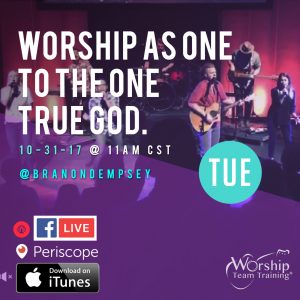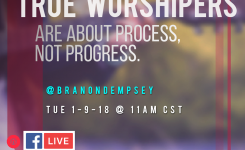Worship Planning, Worship Theology, WTTU Special Public Post
Show #142 | “Intergenerational Worship 10-31-17
2 min read | 30m Show
Generations Together
As a worship leader, do you struggle with divisions in your church between the different generations?Maybe you have the generations separated by having them in different styled worship services. Maybe they are in the same room, but there is animosity and anger building up between the generations because of worship preferences.What does the Bible say about generations worshiping together?
Learn one model for intergenerational worship that features all the generations worshiping together, and each generation offering a “sacrifice of praise”.
10-31-17 WATCH SHOW #142
Watch Live by: FacebookLive or Periscope
Making the Case For Intergenerational Worship
One of the most profound passages in the Bible illustrating the power of intergenerational/ family-style worship is found in the book of Nehemiah. The eighth chapter starts with Israel returning to Jerusalem from years in exile. God’s people were gathered as one in a square near the Water Gate. Ezra read the Book of the Law of Moses, communicating in such a way that the Word was understood by all (young and old, female and male, etc.). He read in the presence of families, and he taught from a wooden platform that was constructed so Ezra could be seen above the people—moms, dads, and children alike. There Ezra blessed the Lord, and “the people answered, ‘Amen, Amen,’ lifting up their hands. And they bowed their heads and worshiped the Lord with their faces to the ground” (Neh. 8:6).The purpose of gathering as families in worship, suggests John Piper, is that the church is actually comprised of mini-churches that worship in individual homes. (John Piper, “Leading Family Worship,” Desiring God, February 2, 2011 (accessed October 11, 2017), https://www.desiringgod.org/messages/leading-family-worship.)
Another place in Scripture where the importance of family worship was prominent is Joshua 24:15. There the great leader Joshua proclaimed: And if it is evil in your eyes to serve the Lord, choose this day whom you will serve, whether the gods your fathers served in the region beyond the River, or the gods of the Amorites in whose land you dwell. But as for me and my house, we will serve the Lord (ESV, italics added).Piper also emphasizes the importance of the family unit in worship: “Our God is a family God. He is a triune God. He is an intra-Trinitarian relationship.
That is the basis of family relationships.” Therefore, churches do well to imitate the example of the family in corporate worship, including models of order, stability, nurture, and authority.Households and families, according to the U.S. Census Bureau’s definition, are not necessarily the same thing. “A household is composed of one or more persons who inhabit a housing unit.”(Jason Fields and Lynne M. Casper, “America’s Families and Living Arrangements,” Current Population Reports P20-537 (2001): 1.) Family-oriented households contain two or more people who are related by birth, marriage, or adoption, though family units may also include individuals who are unrelated.
In any event, families are a unit that even the U.S. government deems to be a building block of society. Sociologists say that people are related to society by way of their families and households. (Joseph A. McFalls Jr., “What’s a Household? What’s a Family?” November 2003, Population Reference Bureau (accessed October 11, 2017), http://www.prb.org/Publications/Articles/2003/WhatsaHouseholdWhatsaFamily.aspx)
The 1st century church understood that by Roman authority the family was linked between empire and household, of which the kingdom was seen as the ultimate household. (E.M. Lassen, The Roman Family: Ideal and Metaphor. In Constructing Early Christian Families. Family as Social Reality and Metaphor, H. Moxnesed, ed. (London, New York: Routledge, 1997), 103-120.) The church takes on a similar model of order (1 Tim. 3:14- 15).
Nurturing A Family Environment in Worship
Establishing and maintaining a family and intergenerational purpose in worship must be attained with intentionality. This requires teaching the body to build a strong system for discipling new believers. It also involves teaching a younger generation to aspire to leadership and to become wholehearted worshipers.
Young people must be given a strong example of fatherhood and motherhood, brotherhood, and what it means to be an obedient child of God in the home and in the kingdom of God. This family awareness strengthens the biblical authority that must be practiced in the church, which involves proper leadership standards and a respect for structure, leadership, and accountability.
Training for leadership is vital in the church. Opportunities must be given very early with young people participating in worship in song and even in children helping to collect the offering during Sunday evening services. Young people, through the leadership of the student ministry must also be given opportunities to occasionally lead in worship on Sunday mornings. The young worship leaders are taught to not only lead the songs that are precious to them but to also respect older generations and their worship heritage, and are instructed to choose and lead songs accordingly.
The greatest challenge where I serve is to encourage those of differing generations to make their own “sacrifice of praise.” This means that, especially the older generation, see the importance of raising up a new generation of young adults to someday take the lead in both management and ministry within the church. The older generation must sacrifice their stylistic preferences in worship for a new generation to flourish.
In this minister’s church, the organ and piano players are given opportunity within each service to lead out and accompany the invitation along with the worship leader. Also, the traditional instruments are given a slot each week during the offertory to do whatever songs they select. The services are always designed to bring multiple generations together—what is widely known as blended worship.
This combination of old and new requires each generation to submit to God with the intention that successive generations carry on a rich heritage of worship music, but also are allowed to introduce songs from their own time and culture—providing the songs are Christ-honoring, biblical, and gospel- centered. It requires a “sacrifice of praise” for everyone in the congregation, and promotes a spirit of servanthood among all believers.
Luke 14:11 and 18:14, respectively, display the significance of servanthood in intergenerational worship: “For everyone who exalts himself will be humbled, and he who humbles himself will be exalted; For everyone who exalts himself will be humbled, but the one who humbles himself will be exalted” (ESV). James 2:8-9 says, “If you really fulfill the royal law according to the Scripture, ‘You shall love your neighbor as yourself,’ you are doing well. But if you show partiality, you are committing sin and are convicted by the law as transgressors” (ESV).
Exhibiting preference toward a certain age group in the church is displaying partiality. [ctt template=”6″ link=”7Pl1I” via=”no” ] “For everyone who exalts himself will be humbled, and he who humbles himself will be exalted; For everyone who exalts himself will be humbled, but the one who humbles himself will be exalted” (Luke 14:11)[/ctt]
Securing the Future of Intergenerational Worship in the Church
Worshiping in an environment where people of every age are unified under one roof is difficult and must be accomplished through strong leadership. It is incumbent upon each pastor and other leadership to communicate the value of intergenerational worship. For instance, the choir and worship team must be united in the effort to serve multiple age groups, and to participate even when the music or a presentation is not an individual’s preference. Commitment to winning souls for Christ and to making disciples and wholehearted worshipers in successive generations trump any other motive.
This outlook must be bathed in prayer. There are spiritual forces that would disrupt a church and thwart families from thriving together in worship. Again, intentionality is the key. People do not simply learn to lead by osmosis—although a good example is essential; they must be guided and instructed.  As an exclusive songwriter with the worship company Integrity Music, Jamie Harvill wrote several popular worship songs, including “Ancient of Days,” “Because We Believe,” “Firm Foundation,” and “Garments of Praise.” He has authored two books: Worship Foundry and To Jesus We Sing. As a conference teacher and songwriter for a number of years and serving local churches, Jamie felt led to teach worship in an academic setting.
As an exclusive songwriter with the worship company Integrity Music, Jamie Harvill wrote several popular worship songs, including “Ancient of Days,” “Because We Believe,” “Firm Foundation,” and “Garments of Praise.” He has authored two books: Worship Foundry and To Jesus We Sing. As a conference teacher and songwriter for a number of years and serving local churches, Jamie felt led to teach worship in an academic setting.
He earned a Master of Arts degree in Worship Studies from Liberty University in Lynchburg, Virginia, and is currently pursuing a Doctor of Worship Studies degree at Liberty. Brenda and Jamie have two married children, four amazing grandchildren, with a fifth arriving soon. Jamie continues to write songs, record, play guitar, teach, blog, and mentor. He serves as an associate pastor and worship leader at a wonderful multigenerational church in the Mobile area.
@jkharvill @BranonDempsey @worshiptt @WorshipTTU
Want to watch MORE Worship Team Training Videos?
Not a WTTU Member, or Choose to Upgrade? Update Now
Worship Team Training® Ever thought about training your team, but don’t have the time to do it?We can take you there with giving your team a Friday-Saturday workshop. Inspire, create and transform the leading of worship.
Get a WeekendWorkshop










